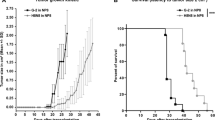A metastasizing mouse cell line (TS/A), originated from a mammary adenocarcinoma which arose spontaneously in a BALB/c female retired breeder, has been established in vitro. It displayed a remarkable morphologic heterogeneity, which is evident in plastic adherent cultures (cell types ranging from epithelial-like to fibroblast-like) as well as in semi-solid agar cultures. The TS/A line exhibited the presence of specific cytoplasmic estradiol receptor, with a binding activity of 16 fmoles/mg cytosol protein. The in vivo growth pattern was as follows: (1) a s.c. inoculum of 105 cells caused a 100 per cent tumor take and kill in syngeneic animals; mean survival time was 54 + 1 days; (2) it did not show significant transplant immunogenicity in syngeneic animals; (3) it was able to give rise to both spontaneous lung metastases and artificial lung colonies; (4) it had a high capacity to grow in H-2 matched, minor histocompatibility antigen incompatible hosts (106 cells killed 100 per cent DBA/2 mice in 58 + 2 days). This line of spontaneous mammary tumor cells is proposed as a useful model for studies on the heterogeneity of the neoplastic population in relation to metastatic spread, on tumor immunogenicity, and on therapy of mammary neoplasia.
Similar content being viewed by others
References
Alexander, P., 1982, The role of the host in metastasis. Accomplishments in Cancer Research 1981, edited by J. G. Fortner and J. E. Rhoads (Philadelphia-Toronto: J. B. Lippincott Company), pp. 138–148.
Bradford, M. M., 1976, A rapid and sensitive method for the quantitation of microgram quantities of protein utilizing the principle of protein dye binding. Analytical Biochemistry, 72, 248–254.
Chandradasa, K. D., and Blears, J., 1982, Studies with a spontaneous murine tumour—I. Indetectability of host immune resistance with tumour-activated elaboration of T cell stimulatory lymphokines in vitro. European Journal of Cancer and Clinical Oncology, 18, 853–859.
Chen, T. R., 1977, In situ detection of mycoplasma contamination in cell cultures by fluorescent Hoechst 33258 stain. Experimental Cell Research, 104, 255–262.
Danielson, K. G., Anderson, L. W., and Hosick, H. L., 1980, Selection and characterization in culture of mammary tumor cells with distinctive growth properties in vivo. Cancer Research, 40, 1812–1819.
Dexter, D. L., Kowalski, H. M., Blazar, B. A., Fligiel, Z., Vogel, R., and Heppner, G., 1978, Heterogeneity of tumor cells from a single mouse mammary tumor. Cancer Research, 38, 3174–3181.
Fidler, I. J., and Kripke, M. L., 1977, Metastasis results from preexisting variant cells within a malignant tumor. Science, 197, 893–895.
Forni, G., Varesio, L., Giovarelli, M., and Landolfo, S., 1979, Source of tumor cells influences their immune recognition by H-2-matched mice. Transplantation, 27, 433–435.
Fumero, S., Berruto, G. P., Pelizzola, D., Grilli, S., Buttazzi, C., Di Fronzo, G., Ronchi, E., Bozzetti, C., Mort, P., Concolino, G., Marocchi, A., Robustelli, Della Cuna, G., Zibera, C., Cerrutti, G., Ros, A., and Piffanelli, A., 1981, Results of the Italian Interlaboratory quality control program for estradiol receptor assay. Tumori, 67, 301–306.
Galili, N., Naor, B., Åsiö, B., and Klein, G., 1976, Induction of immune responsiveness in a genetically low-responsive tumor-host combination by chemical modification of the immunogen. European Journal of Immunology, 6, 473–476.
Hewitt, H. B., Blake, E. R., and Walder, A. S., 1976, A critique of the evidence for host defense against cancer based on personal studies of 27 murine tumours of spontaneous origin. British Journal of Cancer, 33, 241–259.
Hewitt, H. B., 1982, Animal tumor models and their relevance to human tumor immunology. Journal of Biological Response Modifiers, 1, 107–119.
Nanni, P., De Giovanni, C., Galli, M. C., Grilli, S., Lollini, P.-L., Nicoletti, G., and Prodi, G., 1981, Minor histocompatibility antigens do not enhance BALB/c anti-SV40 TASA response. British Journal of Cancer, 44, 588–591.
Wexler, H., 1966, Accurate identification of experimental pulmonary metastases. Journal of National Cancer Institute, 36, 641–645.
Author information
Authors and Affiliations
Rights and permissions
About this article
Cite this article
Nanni, P., De Giovanni, C., Lollini, PL. et al. TS/A: a new metastasizing cell line from a BALB/c spontaneous mammary adenocarcinoma. Clin Exp Metast 1, 373–380 (1983). https://doi.org/10.1007/BF00121199
Received:
Accepted:
Issue Date:
DOI: https://doi.org/10.1007/BF00121199




